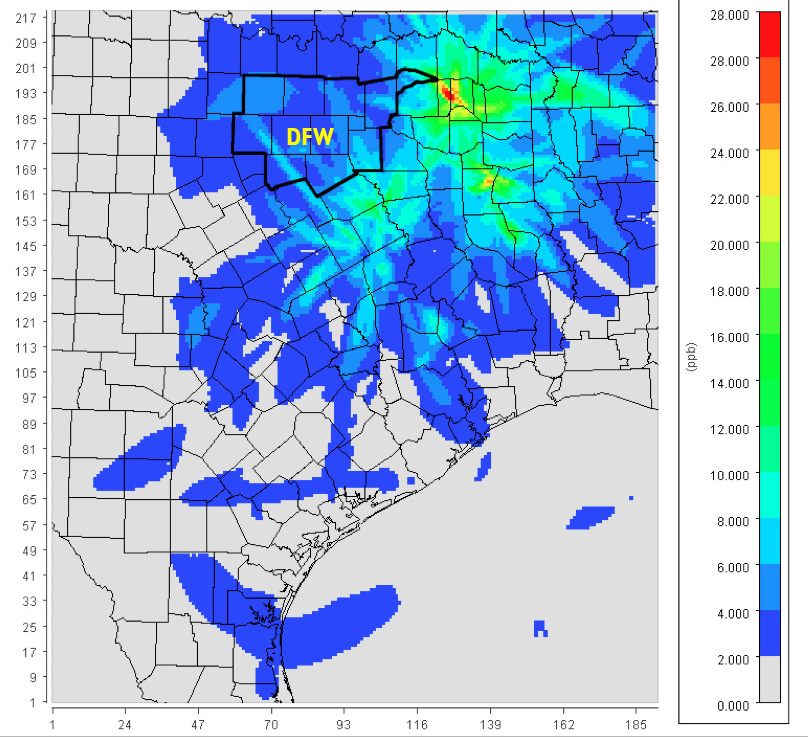Greenhouse Gases
Ready to Fight Back and Win? Downwinders is about to launch its most ambitious campaign in years

Mercifully, the 2015 Texas Legislative Session is almost over. Since January we've seen cities stripped of their traditional zoning power over oil and gas facilities, citizens' ability to challenge new pollution permits further suppressed, and renewable energy sources singled-out for financial punishment.
But the circus leaves town on June 1, and shortly after that Downwinders at Risk will be gearing up for the largest clean air campaign we've taken on since our fight against hazardous waste burning in the Midlothian cement kilns.
It'll begin with the mid-summer release of the results of a years-in-the-making project that turns the tables on the recent trend to transfer all pollution decisions from local governments to Austin. For the first time, city and county officials in North Texas will have the power to do what, up until now, only state agencies could do.
We don't want to give away too much too soon, but this is by far the single most costly project we've ever sought funding for, and it will have an impact on every major industrial source of pollution affecting Dallas-Fort Worth air quality – the cement kilns, the oil and gas industry and the obsolete East and Central Texas coal plants. And It's being done in a way that makes its results unimpeachable by a hostile state government and industry.
As a kind of sneak peak, below is a small sample of what we're talking about. It's a map of our half of Texas with the DFW metropolitan area outlined in black near the top. It shows the reach and intensity of smog pollution from the five coal plants closest to us. Even though they're 90 to over 100 miles away, they're still able to raise smog levels in central DFW by 4 to 8 parts per billion or more – a huge amount that could make or break our compliance with the Clean Air Act.
 This is a map the Texas Commission on Environmental Quality has the ability to produce, but refuses to. Now, we have the same ability. And we can aim it at any large industrial source of pollution in the region. And we have.
This is a map the Texas Commission on Environmental Quality has the ability to produce, but refuses to. Now, we have the same ability. And we can aim it at any large industrial source of pollution in the region. And we have.
Moreover, the results of our study are being released in tandem with an associated project by Dr. Robert Haley and the University of Texas – Southwestern Medial Center. Together, they'll represent the opening salvos to a sustained, multi-organizational campaign to address DFW's chronic bad air problems.
Armed with this new evidence and having identified some chinks in the armor of the Status Quo, we see a chance to strike a powerful blow for cleaner air and citizen power. We see a chance to win a significant victory. We don't know about you, but after the last five months, we could sure use some victories.
That's not to say winning will come easy. It's still Texas. But we hope you'll agree that one of they keys to our long track record of success is picking the battles and the battlefields that give us better odds.
Every dollar you give goes to fight
for cleaner air right here in N. Texas
Not A Surprise: Pollution Reduction Helps Low Income Populations
 One of the most insincere and transparent memes polluters use these days is their sudden concern for the incomes fo poor folks if government forces them to reduce their pollution (we're looking at you Energy In Depth's Steve Everley). "If you make it harder for us to release our crap (into mostly low-income neighborhoods), energy costs and the prices of consumer goods will increase, taking money out of the pockets of people who need it most."
One of the most insincere and transparent memes polluters use these days is their sudden concern for the incomes fo poor folks if government forces them to reduce their pollution (we're looking at you Energy In Depth's Steve Everley). "If you make it harder for us to release our crap (into mostly low-income neighborhoods), energy costs and the prices of consumer goods will increase, taking money out of the pockets of people who need it most."
Ignoring the fact that none of these entities are working on behalf of the poor when they're not making this argument, a new study takes on that argument at face value, and finds, not surprisingly, that it's wrong.
Cutting greenhouse-gas pollution will mean cleaner air and cheaper electricity, according to a Natural Resources Defense Council report that offers a defense of the Obama Administration's Clean Power Plan, the goal of which is to reduce that pollution by 30% by 2030.
In this scenario, it's the owners of obsolete and dirty coal plants that are making the case that making them cut back on planet-wrecking pollution would cause their facilities to close down or add costly controls, resulting in the loss of jobs and higher electirc bills.
But according to the EPA, the initiative will actually cut electric bills by 8 percent and the NRDC study concludes it will create as many as 274,00 jobs in energy-efficiency projects, not to mention new renewable energy positions.
NRDC's numbers show that the country is at a tipping point now where the costs of efficiency and renewables are cheaper to tap into than traditional fossil fuel power sources. It notes the operator of the nation’s largest power grid, "PJM Interconnection" found that generating 30 percent of the electricity in its region from renewable energy sources could save consumers up to 30 percent on their bills.
That conclusion echoes the 2013 report by Daniel Cohan, released by the Dallas County Medical Society in its unsuccessful bid to petition the Texas Commission on Environmental Quality to close Luminant's three older East Texas coal plans. It found that when the costs of becoming a modern Clean Air Act-abiding facility was factored in, the per kilowatt rate of electricity from those dirty coal plants made renewables like wind and solar competitive, and efficiency cheaper outright.
Our energy menu is now much bigger than "nukes or coal." One of the bright spots of the early 21st Century is that we're living in an age when non-fossil fuel alternatives really are a viable market force, in part, because they can not only help reduce the pollution in our air, but also take less of a bite out of our monthly budgets. And for those among us who spend a larger percentage of their budget on basic needs like heating and cooling, this is good, green news.
Both Gas Industry Spinmeister and Mansfield Compressor Spew During Thursday’s EPA Hearing
 There was at least one truth uttered by Steve Everley, the professional PR spokesperson for Energy in Depth, itself the PR arm of the Gas Industry, during his testimony at last Thursday's EPA ozone standard hearing in Arlington:
There was at least one truth uttered by Steve Everley, the professional PR spokesperson for Energy in Depth, itself the PR arm of the Gas Industry, during his testimony at last Thursday's EPA ozone standard hearing in Arlington:
"…natural gas producers will be significantly impacted by EPA’s proposal to reduce the National Ambient Air Quality Standard for ozone from 75 parts per billion to between 65 and 70 ppb."
Indeed. At the rate things are going in Austin and DC, it might be the only thing to impact the industry's large emissions of pollution for many years to come. Left unsaid by Everley was why the industry would be impacted by such a lower ozone standard – because in many parts of the country now, including the DFW area, smog-forming pollution from the gas industry is contributing significantly to higher ozone levels.
Even the governmental affairs branch of the gas industry, otherwise known as the Texas Commission on Environmental Quality, admits that facilities like compressors, storage tanks, pipelines, and de-hydrators found by the thousands in the western part of the Metromess contribute more smog-forming Volatile Organic Compounds (VOCs) than all the "on-road" vehicles in North Texas combined. This is true not only at the present time, but will be true at least three years into the future, according to TCEQ's own estimates.
Gas facilities also account for the third largest source of smog-forming Nitrogen Oxide pollution in DFW, according to TCEQ numbers included in their recent air plan submitted to EPA – only a ton per day less than all "non-road" vehicles in North Texas like construction equipment, and well ahead of "point sources" like the Midlothian cement kilns and local power plants.
In all, TCEQ predicts that 35,335 tons per year of smog-forming pollution will still be coming from the region's gas industry in 2018. That's a lot. It's so much that, as the TCEQ also demonstrates with its computer modeling, even a tweak here and there in gas pollution estimates can make big differences in the levels of ozone at monitors in places like Denton and Keller and Eagle Mountain Lake – traditionally the worst-performing air quality monitors in North Texas.
And that's why a lower ozone standard is a threat to the industry. The very air quality monitors the industry affects most with its pollution are the ones driving the region's high smog levels. Lowering the ozone standard means it would have to spend money to reduce those emissions significantly. It means it would have to spend money to prevent the kind of huge "accidental" releases of smog-forming pollution released by the Mansfield compressor on Thursday even while Steve Everley was testifying to EPA.
After giving her own testimony to EPA on Thursday morning, Earthworks' Sharon Wilson and Mansfield Gas Well Awareness board member Lance Irwin headed out to the Summit Midstream Partners Compressor Station behind Mansfield's Performing Arts Center, with an infrared, or FLIR "thermal imaging" camera. Such a device is capable of recording the kinds of VOC emissions that are often smelled and inhaled by surrounding residents, but can't be seen with the naked eye.
The Summit compressor and the two nearby Eagleridge gas wells have been the scene of many different complaints from the surrounding Mansfield neighborhood – everything from airborne foam landing in backyards to oily deposits landing on car finishes. On Thursday, Wilson and Irwin were responding to a new series of complaints about awful smells. When they showed up, what the two recorded was a massive "emergency blowdown" (versus the "planned" kind). While filming the event, Wilson suffered health effects familiar to gas facility neighbors and was overwhelmed by the obvious hydrocarbon fumes. Once you see her video, you understand why:
Such a blowdown was exactly what Lance Irwin had warned the Mansfield City Council about only three days before, during comments directed at slowing down or denying the permit for a new compressor, 34 wells, 12 tanks and a assortment of other facilities at an Edge pad site near Debbie Lane in town. He pointed out that industry and government estimates about emissions never take these kind of catastrophic events into account – form a short-term toxic exposure perspective, or as it turns out, from an air quality, smog-creating perspective. And he's right.
In this regard, these kinds of accidents are no different than the infamous industrial "burps" from refineries and chemical plants along the Houston Ship Channel that lead to smog spikes downwind. There are 650 large compressor stations in the DFW "non-attainment" area. How many are experiencing blowdowns on any given day? How many are affecting ozone levels in the spring and summer? The TCEQ estimates included in its DFW air plan don't even try to quanify them.
Because gas facilities like compressors are subject only to "standard permits," are located diffusely around a region, and don't officially emit a de minimus amount of air pollution, they're not subject to the federal rule of off-setting. That's when a new polluting facility locates in an already smoggy area like DFW and has to pay to cut smog pollution elsewhere if it wants to emit the stuff itself. If a new cement plant or power plant were to locate in DFW, it would have to pay to reduce a ton and a half of smog-forming pollution for every ton it wanted to release. Gas facilities don't have to do this – even though collectively they emit more smog-forming pollution than all the cement plants and power plant in the non-attainment area!
EPA has tried to argue that a company's different facilities are all tied together and should be counted as a single source, and so subject to off-setting regulations. But the courts have ruled against them.
Rising gas industry pollution and the absence of any official brake on its growth like off-setting is a large reason, maybe the primary reason, why DFW hasn't seen the kind of air quality progress it should have by now. Until this last summer's cooler and wetter weather gave us relief, ozone levels had been stagnating or even rising since 2009 – or about the time the industry invaded North Texas in large numbers. There's no question that had the Barnett Shale boom not happened, we'd have much cleaner air by now.
But it did and we don't. And so that's why a lower ozone standard is perhaps the only way that the gas industry will ever be forced to clean-up its act – especially on the widespread regional level we require to get to safe and legal air. Just like it has with the Midlothian cement plants, the need for lower smog levels can force the state's and industry's to act to add controls. It's a long-term fight, but one of the only paths to across-the-board change versus the city-by-city slog activists have had to rely on.
National Resources Defense Council lawyer John Walke has a great takedown of Steve Everley's spin on Thursday. And the tireless cross-country DeSmogblog reporter and photographer Julie Dermansky has a good read on the Mansfield fight that you should check out. But the most compelling rebuttal to both industry PR and local governments who want to ignore their own responsibility in this mess is probably Wilson and Irwin's two and a half minutes of video.
After a 14-year Campaign, State-of-the-Art Pollution Control Finally Coming to Midlothian
 (Midlothian) After a 14-year effort by local citizens, Holcim US Inc. is applying for a permit to the Texas Commission on Environmental Quality to install a Selective Catalytic Reduction (SCR) unit in their Midlothian facility. It's the first application for commercial use of SCR technology in any U.S. cement kiln.
(Midlothian) After a 14-year effort by local citizens, Holcim US Inc. is applying for a permit to the Texas Commission on Environmental Quality to install a Selective Catalytic Reduction (SCR) unit in their Midlothian facility. It's the first application for commercial use of SCR technology in any U.S. cement kiln.
DFW-based clean air group Downwinders at Risk has been advocating the use of SCR in the three Midlothian cement plants located just south of I-20 since 2000, when a German cement kiln first operated the technology successfully.
Together, the TXI, Ash Grove, and Holcim plants represent the largest concentration of cement manufacturing in the country and are a major contributor to DFW's historic smog problem.
"We need this pollution control technology in North Texas, and we're pleased to see Holcim's application," said Downwinders Director Jim Schermbeck. "But we wish residents could enjoy its results sooner than Holcim intends."
The SCR unit is planned for Holcim's idle Kiln #2 while a more common Regenerative Thermal Oxidizer will be built for its operating Kiln #1. Both technologies are being installed to meet new EPA emission standards for hydrocarbon pollution from cement plants. Those standards themselves were championed by Downwinders and other citizen groups in 2009, with over 200 people showing up at an EPA hearing the the DFW Airport Hotel to support them.
The deadline for compliance with the new standards is September 2016. However, restarting of Kiln #2, and the introduction of SCR in Midlothian, is dependent on local demand for Holcim's cement, which is still recovering from weak demand during the recession. That lack of demand could delay the technology's inauguration until after 2016.
Nevertheless, according to Schermbeck, Holcim's application for a permit to install SCR makes it's more likely that all of the Midlothian cement plants, and others in EPA "non-attainment areas" for smog pollution around the country, will be adopting it sooner rather than later.
"Holcim's application sets a precedent that's hard to ignore by regulators in Austin and Washington. For the first time a US cement plant has expressed enough confidence in SCR to make it a technically and economically-viable choice for pollution control. There's no going back."
SCR is widely considered to be the most advanced form of pollution control for cement manufacturing, capable of reducing smog-forming pollution by 90% or more, along with significant reductions in Particulate Matter, metals, and Dioxins.
Although about half a dozen European cement kilns are successfully operating the technology, U.S. plants have refused to endorse it. Two EPA-sponsored pilot tests of SCR are being conducted at Indiana and Illinois cement kilns as part of court-ordered settlements. Holcim's application for its Midlothian kiln is the first time and American cement plant is voluntarily approving SCR use.
Although it's not coming in time to impact the current DFW clean air plan, due to go to public hearing in January of next year, Holcim's application will put SCR on the agenda for the next such plan.
Just two weeks ago, EPA staff recommended a new ozone, or smog, standard of between 60 and 70 parts per billion over an eight hour period versus the current limit of 75 ppb. Adoption of a stricter standard is expected to occur by late next year, meaning a plan to meet that standard will be gearing up sometime in the next three to five years. By that time, Holcim's SCR unit should have a track record that can be cited as a reason for all the Midlothian cement plants to use it.
Schermbeck noted that just last month representatives of the TCEQ told a regional air quality meeting in Arlington that SCR was neither an economical nor technically feasible pollution control option for the Midlothian cement plants. He said Holcim's application belies that claim.
A public meeting on the Holcim permit application is being scheduled for early November.
Arrival of SCR on the scene marks the latest and the most dramatic milestone in the transformation of the local cement industry since Downwinders at Risk was founded 20 years ago to stop the burning of hazardous wastes in the Midlothian kilns.
After a 14-year battle, TXI halted its hazardous waste-burning operations in 2008. Downwinders then pursued a six-year "green cement" campaign to replace all seven obsolete and dirtier wet kilns with newer "dry kiln" technology. That campaign ended in 2012 with the announcement that Ash Grove would shutter its three wet kilns and build a new dry kiln in their place. That plant is due to go on line this year.
Adoption of SCR remained a goal of the group through four different DFW clean air plans going all the way back to 2000. Schermbeck said his group made incremental progress each time, winning small and large battles that directly lead to today's news.
"Holcim's application for SCR is the latest testament to the persistence and focus of a small group of committed citizens who have pulled and pushed the U.S. cement industry into the 21st Century one step at a time."
Ask the State and Holcim To Finally Give DFW “the Holy Grail” of Cement Pollution Control Technology
 Swiss-based Holcim Cement is requesting a permit amendment to add new piece of pollution control equipment to its Midlothian cement plant, one of three cement plants that make the city the "Cement Capitol of Texas" and the largest concentration of cement manufacturing in the U.S. Good news, right? The problem is that the company is asking the state for the permit before deciding what kind of pollution control equipment to install.
Swiss-based Holcim Cement is requesting a permit amendment to add new piece of pollution control equipment to its Midlothian cement plant, one of three cement plants that make the city the "Cement Capitol of Texas" and the largest concentration of cement manufacturing in the U.S. Good news, right? The problem is that the company is asking the state for the permit before deciding what kind of pollution control equipment to install.
That's right. Holcim is asking the Texas Commission on Environmental Quality (TCEQ) to OK a permit that will result in a "major modification" of its Midlothian plant and could produce significant amounts of new pollution before it even decides what the major modification is going to be. Anywhere else in the country this might be a bit odd, but hey, it's Texas, where Rick Perry's TCEQ has a rubber stamp standing by for anything industry requests.
Holcim's permit request is being prompted by a problem complying with new federal regulations limiting a kind of pollution called Total Hydrocarbons, or THCs. These are also sometimes referred to as "Volatile Organic Compounds." Think Benzene, and other kinds of hazardous flammable gases. In its permit application Holcim says it needs to add new controls to reduce THC to levels and come under the new federal standard. Fair enough. The company then says that it's still trying to decide between two different types of controls and will make up its mind after getting the permit and seeing how well its choice works out on one of its two separate giant kilns. That's the bogus part.
But wait, there's more! The two technologies Holcim is considering installing in Midlothian are: 1) A Regenerative Thermal Oxidizer, or RTO, which is a fancy way of saying setting them on fire and flaring them off, and, 2) A Selective Catalytic Reduction unit, or SCR, which is a tower of treated metal honeycombs that pick up pollution as the plant exhaust passes through them. RTOs are already installed on American cement plants, including TXI's huge Midlothian kiln just a few miles down Highway 67 from Holcim. On the other hand, up to now full-scale commercial SCR units have only been installed on European cement plants and in fact, the Portland Cement Association has lobbied long and hard to keep them out of the US for fear of raising the pollution control bar too high for all of the country's cement plants.
That's because SCR is more expensive to build and maintain than most cement plant control devices. But for the money, you get the Holy Grail of cement plant pollution control technology.
Most of the European cement plants that have SCR units install them to remove another type of pollution from their stacks – Nitrogen Oxides (NOx). If that sounds familiar, it's because NOx is a major smog-forming pollutant, and DFW has so much of it that the region has never been in compliance with the Clean Air Act standard for smog. And you'll never guess which facilities are the single largest sources of NOx pollution in North Texas. Or maybe you will: the Midlothian cement plants. That's why Downwinders at Risk has made it a point to campaign to require all three Midlothian cement plants – Holcim, TXI and Ash Grove – to install SCR….since all the way back in 2001, when the first European units were deemed a success at a German cement plant. SCR can remove 80 to more than 90% of all NOx coming out of a cement kiln. The 6500 tons of NOx a year that the Midlothian cement plants are permitted to release could be reduced to 650 tons with the application of SCR.
Now, as it turns out, SCR units are great not only at capturing large amounts of NOx pollution, but all kinds of other industrial pollution coming out of cement plants as well. Like THCs – up to 70% or so, but also Particulate Matter, Metals, Greenhouse Gases, Carbon Monoxide, and Dioxins. It's what's called a multi-pollutant control device because it does such a good job of eliminating a wide variety of nasty stuff from smoke stacks. This is what makes it the state-of-the-art technology for communities hosting kilns. In contrast, RTOs are single-purpose pollution devices aimed just at hydrocarbon removal and aren't designed to remove other kinds of emissions.
So even though Holcim is considering operating SCR because of its hydrocarbon problem, it would have a massive impact on the plant's air pollution across the board. And if Holcim were to set the precedent, the clock would begin ticking on bringing SCR to the other two Midlothian cement plants as well. It would only be a matter of time.
The public comment period for telling the state whether to accept or reject Holcim's permit application ends this Friday, July 11th at 5 pm. (If you're interested in jumping through the hoops to fill out the online form for official comments, you can go here and use Permit Number 8996)
Downwinders is submitting detailed comments praising Holcim for considering SCR, but urging the TCEQ to reject this permit because it's too vague and doesn't commit the company to any partciular technology, including SCR. We've also been collecting letters form local officials and stare legislators that urge Holcim to definitively choose SCR.
Now we're asking you to help us bombard both the Texas Commission on Environmental Quality and Holcim's US headquarters in Dundee Michigan in the next 48 hours with the same message to show public support for the company to do the right thing while rejecting a placeholder permit that doesn't commit it to do that right thing.
We want a permit request from the company that says Holcim will definitely install SCR, becoming the first commercial application of this state-of-the-art technology in America.
Using our "Featured Citizen Action" link, you can send such a message to Austin and Michigan in a matter of seconds right now. All you have to do is click here and then send the e-mails. We guarantee there's no more important or easier thing you can do for clean air in North Texas this week than sending these e-mails to the TCEQ Commisisoners and Holcim Corporate leadership. Please help us get the cement plant pollution control technology DFW deserves. It will only take a matter of seconds for you to help us achieve a goal we've been working toward for 14 years. We can do this. But we need your help. Now. Thanks.
Study: Climate Change Will Likely Increase DFW Smog
 Just last week at the June regional air quality planning meeting the Texas Commission on Environmental Quality was bemoaning the fact that the weather too often determines how bad an "ozone season" DFW will have. And it's true. When we have really hot, dry, and windless summers, ozone levels soar as they did as recently as 2011-2012 when the recent drought seemed to reach its most awful heights in DFW. Conversely, when we have relatively cool, wet and windy summers, ozone levels abate, as they seem to be doing this year – at least so far.
Just last week at the June regional air quality planning meeting the Texas Commission on Environmental Quality was bemoaning the fact that the weather too often determines how bad an "ozone season" DFW will have. And it's true. When we have really hot, dry, and windless summers, ozone levels soar as they did as recently as 2011-2012 when the recent drought seemed to reach its most awful heights in DFW. Conversely, when we have relatively cool, wet and windy summers, ozone levels abate, as they seem to be doing this year – at least so far.
Of course, the TCEQ spokesperson was using weather as an excuse why DFW hadn't yet achieved compliance with the 1997 ozone standard after two tries that fell short. Completely overlooked was the fact that the last state air plan for DFW in 2011 promised historically low ozone levels by 2013 without any new pollution controls on major sources of pollution. Combine that lack of action with a really hot, dry summer like we saw in 2011, and you get the first clean air plan ever to leave ozone levels higher after it ended than when it started.
That's why it's important to think about the weather when you're trying to build new clean air plans for DFW that stretch years into the future. Air quality planners have to ask themselves if between now and the next federal clean air plan deadline of 2018, will there be more summers like this seemingly anomalous one, or will they more like the summer of 2011 when we had a constant barrage of 100 degree plus days as early as March?
Currently, the TCEQ is using a stretch of bad air days from 2006 to predict ozone levels between now and 2018 in their computer model for the DFW air plan to comply with the new, tougher 2008 ozone standard. But 2006 was pre-drought. Although they say they're "adjusting" the meteorology to compensate for weather changes since then, do you really trust TCEQ to assume worst-case weather scenarios when they're still trying to hide the smog impacts of gas pollution from the public? Us either.
So it's with more than a little self-interest that we note a new Stanford study with the too-sexy title of "Occurrence and Persistence of Future Atmospheric Stagnation Events" concluding that the Western US, including Texas, should expect hotter and therefore smoggier summers thanks to climate change. Why? Because hotter temperatures will slow the flow of air around the globe. That means less wind, and less wind means more time for smog-forming chemicals to sit and bake in the hot sun and form harmful levels of ozone. Historically, most of our worst ozone days are when winds are blowing less than 5 mph – stagnate air.
DFW isn't like Denver or LA where mountains form bowls around the urban areas and trap pollution in inversions. But the new study concludes the impact from global warming could have the same effect on the Texas prairie by stagnating air currents:
"Our analysis projects increases in stagnation occurrence that cover 55% of the current global population, with areas of increase affecting ten times more people than areas of decrease. By the late twenty-first century, robust increases of up to 40 days per year are projected throughout the majority of the tropics and subtropics, as well as within isolated mid-latitude regions. Potential impacts over India, Mexico and the western US are particularly acute owing to the intersection of large populations and increases in the persistence of stagnation events, including those of extreme duration. These results indicate that anthropogenic climate change is likely to alter the level of pollutant management required to meet future air quality targets."
And who's more prepared to deal with the "pollution management required to meet future (re: tougher) air quality targets than the Texas Commission on Environmental Quality? Almost any one, including your 13-year old niece who's done so well in 8th grade science this year. Because not only is it the TCEQ's official position that smog isn't all that bad for you, but that there's really no such thing as climate change. It's why you should bring a boatload of skepticism to the computer model that's driving the currently proposed DFW clean air plan. To plug hotter and hotter temps into the DFW smog model for coming years would be admitting to a phenomena that the Rick Perry administration in Austin just can't bring itself to concede. One more example of how the DFW plan is being driven by politics, not science.
As the TCEQ's own staff admitted last week, DFW's ozone levels are often hostage to the weather. If you're model isn't correctly estimating the weather during future ozone seasons, chances are your estimates of future ozone levels will be off as well. But of course, since smog isn't really bad for you there's no downside to being wrong about these things at TCEQ HQ, and only an upside in GOP primaries.
For the rest of us who believe what the science tells us, the consequences are more dire. As the VICE magazine take on the Stanford study said:
"….one reason this study is so important to the climate change conversation—it underlines the public health threat posed by climbing temps. When Obama was touting the EPA's new carbon regulations, he emphasized the public health benefits of drawing down emissions: It would reduce asthma and respiratory illness, he pointed out. But that's largely because shuttering dirty power plants cuts both carbon and particulate pollutants simultaneously; fighting climate change also means fighting asthma.
Now, scientists have demonstrated there's an additional layer of concern to grapple with on the pollution front; climate change is going to begin blocking cities' toxic release valves. If we don't work to slow carbon emissions, these steamier cities will find their streets clogged with stagnant smog. Scrubbing that pollution and finding novel ways to clear the air, too, then, will prove to be a pressing concern in the not-so-distant future.
Show Me the Money: Putting a Dollar Value on Climate Change
 How do you monetize a human life? How about when that life is impaired with an illness? What's it worth to you not having to rush your child to the emergency room when they're turning blue during an asthma attack? What about to prevent a heart attack?
How do you monetize a human life? How about when that life is impaired with an illness? What's it worth to you not having to rush your child to the emergency room when they're turning blue during an asthma attack? What about to prevent a heart attack?
These days we live in a cost-benefit world that demands this kind of accounting for things that should be accepted at face value. Want to talk about the advantages of cleaner air? You have to be able to put a price tag on it. And, with a small slight of hand, that's what the Obama administration did when it touted all the economic reasons why its new carbon capture rule for existing power plants was a plus for the country.
Carbon pollution itself doesn't directly cause the kind of death and suffering among humans that the Clean Air Act was written to address. Oh sure, it might doom countless species, raise sea levels, and cause global catastrophe, but there's not a way to tie it directly to more mundane respiratory diseases or early mortality that we (well, everyone but the Texas Commission on Environmental Quality) associate with "air pollution."
Instead of pricing catastrophic planetary effects, no matter how self-evident their true costs might be, the EPA instead sought out to tag the out of pocket expenses saved by Americans in cutting pollution associated with carbon, like Particulate Matter and smog. Most of the $55 to $93 billion in economic gains cited by the EPA last week came from these co-benefits, rather than from added spending and jobs in renewable energy or preventing massive crop failures. Otherwise, the new rules might not have been "worth it" from a regulatory point of view. The administration projects the new rules will cause the loss of between 79,900 and 80,400 full-time equivalent jobs in power generation versus 111,800 full-time equivalent jobs in renewable or energy efficiency work, basically a wash.
Want to know the price of an asthma attack? $58. Multiply that by 140,000 to 150,000 across the country and you have the approximately $9 million saved over the next 15 years by reducing soot and smog – a side effect of reducing carbon pollution under the rules.
Non-fatal heart attacks cost an average of $98,000 in health care costs and lost earning power among under-25-year-olds versus an average of $200,000 among 55- to 64-year-olds, because this later demographic is supposedly reaching its peak earning power. Preventing a six-day bronchitis episode is valued at $430.
By far the largest single health impact from the carbon rules seems to come from the forecasted reduction in deaths associated with PM pollution, quickly becoming the most insidious and widespread air pollution threat in the world, and smog. EPA economists estimated savings of between $27.3 billion and $66.7 billion from lower levels of PM 2.5 (fine particles smaller than 2.5 microns in size) and Nitrogen Oxide by preventing 2,700 and 6,600 early deaths.
Most of these numbers come from anticipated cleaner or closed coal plants. It's not unusual for EPA to do accounting this way for the rules it's proposing, although it's the first time it's used it to justify carbon pollution regs.
Will these kinds of arguments win over the skeptics? Doubtful, but that's not who they're aimed at. Instead the administration is using these numbers as talking points to the media and the public in hopes of creating momentum the skeptics can't reverse or rationalize. After all, it's hard for even Rick Perry to call out your child's asthma attacks as unimportant or inconsequential.
Big Green Discovers It Needs More Than A DC Office to Win
 In 2010, there was a very large and coordinated push by the nation's largest environmental groups and President Obama to get climate change legislation through Congress. Even with a "Democratically-controlled Congress" it failed.
In 2010, there was a very large and coordinated push by the nation's largest environmental groups and President Obama to get climate change legislation through Congress. Even with a "Democratically-controlled Congress" it failed.
Four years later, the president has ditched Congress and is resorting to his executive authority under the Clean Air Act to initiate a cap and trade system for CO2 that reportedly will demand a 30% drop in emissions from 2005 levels from the country's existing power plants. There are lots of potential land mines in this approach – if it can survive the gauntlet of legal challenges form industry. And if it does?
"It's going to be like eating spaghetti with a spoon. It can be done, but it's going to be messy and slow," said Michael Gerrard, director of the Center for Climate Change Law at Columbia University.
As for Big Green, it's discovered that DC lobbyists and think tank policy analysts do not a movement make. Prompted by their own failure, a soul-searching New Yorker article in 2013 questioning the wisdom of a corporate-like top down approach, as well as new groups that were filling the vacuum of leadership – like the more radical and highly decentralized Keystone campaigns, a change in perspective begin to occur.
“The national environmental groups said, ‘We need to do more in-your-face activism,’ ” said Gene Karpinski, the president of the League of Conservation Voters. “You can’t just lobby members of Congress with a poll that says people support you.”
As a result the big groups have re-tooled to catch-up. They're now sponsoring more direct actions, including divestment campaigns at universities, and public protests, as well as spending big bucks in targeted state elections. They're decamping from the Capitol and spreading out their resources. In doing so, they're building new organizing models for themselves, models that take cue from smaller, more dynamic, more effective grassroots groups. It's a change for the better.
Human-Induced Earthquakes and Cooking the Planet: We’re Living the Next Hollywood Sci-Fi Blockbuster
 "Environmentalism" as a cause in America has its roots in the wilderness, the "otherness" a person can discover when he or she is separated from their own kind and put among crowds of the planet's non-human inhabitants. Walden Pond. National Parks. These were all meant to be meditative retreats from "civilization," from which you could escape. Environmentalism was a revelatory and individualistic experience.
"Environmentalism" as a cause in America has its roots in the wilderness, the "otherness" a person can discover when he or she is separated from their own kind and put among crowds of the planet's non-human inhabitants. Walden Pond. National Parks. These were all meant to be meditative retreats from "civilization," from which you could escape. Environmentalism was a revelatory and individualistic experience.
Then came the understanding of environmentalism as a way to affect collective public health. Air pollution we breathe into our bodies causes lung cancer and asthma. Swallowing water with toxins in it when you're pregnant can cause birth defects. Eating foods with pesticides in them can affect a child's hormones. Still, the impacts were mostly seen person by person, and they depended on lots of variables – genetics, location, exposure. Not in my backyard.
Now however we're in a whole new age of cause and effect. The scale is planetary. The sky we live under as well as the ground we walk on.
Imagine Hollywood makes a movie about alien invaders who want to reshape the Earth for their own purpose, say like "Battleship." They begin pumping in massive quantities of CO2 and methane, driving up the temperature way beyond anything in recent history and setting-off all kinds of chain reactions among species and weather conditions. They begin extracting minerals by poking deep holes in the earth and then setting off large explosions, the waste of which causes not-insignificant earthquake activity when they pump it back into the ground under tremendous pressure. Their huge spaceships sometimes leak radioactivity, and if they just happen to be sitting beside oceans that can be used as industrial-size septic tanks, all the better.
That's what it feels like now, in 2014.
In case you missed it, the United States Geologic Service issued its very first "Earthquake warning" for Oklahoma:
"A new study found that earthquakes in Oklahoma rose by 50 per cent over the last seven months, leading researchers to warn that the risk of a damaging earthquake measuring a magnitude of more than 5.5 has increased significantly in the state. Agencies reported 183 earthquakes of magnitude 3.0 or higher from October until April 14th, compared with an average of only two per year from 1978 to 2008."
Usually reserved for places like California or Alaska to warn residents of the risk of damaging aftershocks, this is the first time the USGS has issued an earthquake warning for a state east of the Rockies. In the Sooner State, the aftershocks are thought to be caused by fracking waste injection wells. A Cornell University study released this week showed a link between waste wells and earthquakes up to 50 kilometers away.
"A new study of the Jones earthquake swarm, occurring near Oklahoma City since 2008, demonstrates that a small cluster of high-volume injection wells triggered earthquakes tens of kilometers away. Both increasing pore pressure and the number of earthquakes were observed migrating away from the injection wells.
"The existing criteria for an induced earthquake do not allow earthquakes associated with the well activity to occur this far away from the wellbore," said Katie Keranen, assistant professor of geophysics at Cornell University, who led the study of the Jones earthquake swarm. "Our results, using seismology and hydrogeology, show a strong link between a small number of wells and earthquakes migrating up to 50 kilometers away" said Keranen. "
Moreover, we're just beginning to understand the threat to infrastructure from human-induced earthquakes…
"Last week scientists attending the Seismological Society of America annual meeting in Anchorage, Alaska called for more research into the relationship between fracking wastewater disposal and earthquake activity.
Gail Atkinson, an earth sciences professor at the University of Western Ontario, presented research at the conference highlighting the “significant and as-yet-unquantified risk” to the integrity of critical infrastructure, such as major dams and nuclear power plants posed by induced seismicity.
Part of the problem is that fault lines in the areas most affected by fracking operations are often poorly and incompletely mapped. Texas, Ohio, Colorado and Oklahoma, which have in recent years experienced unprecedented seismic activity, have never been made a priority like California and other states where quakes have long been a threat."
SMU and USGS scientists looking into the Azle earthquake swarm were also at this same Alaska conference presenting their paper showing the vast majority of recent earthquakes near that city were centered between two injection wells, including a large XTO one. Expect to see some follow-up as reporters and citizens take their first look. And while we really do expect an alien invasion to occur before the State of Texas voluntarily does anything to stop the problem in Azle, there's a House Energy Committee, Seismic Activity Sub-Committee hearing next Monday May 12th, where only invited testimony will be heard. Sharon has the details for folks that want to make another trip to Austin.
Meanwhile, April saw new highs in atmospheric poisoning.…
The end of April has arrived, and with it, the record for the first month in human history with an average carbon dioxide level in Earth’s atmosphere above 400 parts per million has been set.
With a little more than 24 hours left in the month, the average for April can't slip below 400 ppm. “Every day in April has been over 400 ppm,” said Pieter Tans, a climate scientist with the National Oceanic and Atmospheric Administration.
The levels of carbon dioxide in the atmosphere are monitored from a site atop Hawaii’s Mauna Loa volcano, where they have been measured continuously since 1958. The long record has charted the steep rise of the greenhouse gas — the most prevalent in Earth’s atmosphere — as a result of human emissions.
The first measurement in excess of 400 ppm was made on May 9, 2013. This year, the level rose above that mark a full two months earlier, and has remained above 400 ppm steadily since the beginning of April.
And lest you think you'll be long gone before the effects of this change affect you and yours, yesterday's new National Climate Assessment report wants you to know that,
"The effects of human-induced climate change are being felt in every corner of the United States, scientists reported Tuesday, with water growing scarcer in dry regions, torrential rains increasing in wet regions, heat waves becoming more common and more severe, wildfires growing worse, and forests dying under assault from heat-loving insects.
Such sweeping changes have been caused by an average warming of less than 2 degrees Fahrenheit over most land areas of the country in the past century, the scientists found. If greenhouse gases like carbon dioxide and methane continue to escalate at a rapid pace, they said, the warming could conceivably exceed 10 degrees by the end of this century.
“Climate change, once considered an issue for a distant future, has moved firmly into the present,” the scientists declared in a major new report assessing the situation in the United States."
Conscience-ridden scientists making dire warnings about the threat. A government too slow or self-interested to act to thwart the threat. We know this movie. From the POV of the moving camera, we see the same forces of darkness making things go boom underneath us are also filling up our thin layer of atmosphere with gunk. This is no longer something we can escape from, nor is it a matter of local public health. After years of hearing that the sky is falling, now it really is. Only instead of aliens causing it, it's us treating the planet as if we were.
In such a Hollywood Blockbuster, the heroes would be the scrappy, common-sense fueled citizenry who had managed to outrun and outsmart the aliens in various small and large ways while governments fumbled and greedy privateers made deals with the newcomers. With some imagination, a rag tag group of locals fighting a single alien ship out in the boondocks would finally find an out-of-the-box way to disrupt, confuse, and eventually defeat the enemy. As the credits begin to roll, you can see word of this grassroots strategy spread across the globe and its effectiveness showing up in Paris, Moscow, Nairobi, Mexico City, and Hong Kong.
This is that movie. We're in it. Are you a member of the scrappy resistance or an anonymous uncredited crowd extra? Quick, the tide's coming in.….
We Won a Small Victory – Now Come Take Advantage of It
 This is why citizen participation matters.
This is why citizen participation matters.
Last week, local officials were balking at reserving a slot at next Thursday's regional air planning meeting for a presentation by UNT researchers on how gas industry emissions from the Barnett Shale could be adding to DFW's chronic smog.
After reading about the UNT research in the Denton Record Chronicle, Downwinders at Risk and State Representative Lon Burnam specifically asked the local Council of Governments to include the UNT work on the agenda.
At first, we were told that there was already one technical presentation scheduled for the meeting and there wouldn't be any time for a second.
That struck us as strange, since in the past, every such meeting has always had more than one technical presentation.
When we pointed this out in an e-mail with links to past meeting agendas to prove the point, we quickly got a different response. Suddenly, there would be time for the UNT presentation.
That wasn't so hard was it? All it took was a little logical push back. But if we hadn't supplied it, Thursday would be looking a lot different.
Now, we're asking you to please come and help us push back a little more.
State environmental officials are on record as saying the air pollution from gas mining and production in the Barnett Shale is not adding to DFW's smog.
A lot of us think otherwise.
Come next Thursday, on the 17th, you can listen to the new UNT research on fracking air pollution and ask Texas Commission on Environmental Quality officials directly what makes them so sure that gas pollution isn't hurting local air quality.
Because the format of these regional clean air meetings are now so informal, anyone in the audience can ask questions of a presenter. That means you – if you show up.
It doesn't matter if you don't know the technical lingo. This is all about wind direction, weather, and things that pollute. There are no stupid questions.
The new anti-smog plan that the state is building needs all the public scrutiny it can get. It needs tough examination by people who care about clean air and the truth.
Next Thursday, you can help us put the state on the spot.
This is the first opportunity in 2014 to speak up and sound off about our decades-long smog problem. Don't let the TCEQ leave town without hearing from you.
We fought and won the right for you to listen to this research because we thought it was important. Won't you please come and take advantage of this victory?
We need a good showing to prove DFW residents are still mad about breathing dirty air.
NEXT THURSDAY, APRIL 17th
10 am to 12pm
North Central Texas Council of Government headquarters
616 Six Flags Drive
(After the meeting, State Representative Lon Burnam and Downwinders will be hosting a lunch time de-briefing, location to be decided, so stay tuned.)
Look, we know this is a small victory. But state officials don't want to talk about how gas industry pollution may be making our local smog worse, even though there's evidence that it is.
That's exactly why we think we need to keep bringing it up.
Winning the right to hear a new scientific presentation on the connection between gas pollution and smog may not seem like much of a win, but it is when the Powers-That-Be don't want you to hear it.
We know that small victories like this can lead to larger successes.
In the 1990's the same state agency that's now denying gas pollution has any impact on DFW smog was saying exactly the same thing about the Midlothian cement plants.
It took lots of push back from citizens who knew better before we got the state to admit it was wrong.
Now, Ellis County is in the DFW non-attainment area and the cement plants have controls on them they would otherwise never have.
We need the same effort in 2014 to show the state is as wrong about gas industry pollution as it was about the cement plants.
Right now, Downwinders is the only group committed to organizing citizens around clean air issues in DFW.
But we just lost a funding source that was critical to us and we need your help to keep the pressure on. This money paid for staff work in the field.It's very easy to give securely online here, or you can send checks to our P.O. Box at the bottom of the page.
We really need your help. Thank you.
